Published
on 21
Mar 2020
|
All rights reserved.
|
|
|

|
|
Mid-engined
conversion leaves more questions than answers.
|
|
Finally, after 7
generations, Chevrolet finally turns its Corvette into a mid-engined
machine. It might be exciting to some. It might raise eyebrows to
others. However, the most important thing is, its market positioning is
unchanged. Priced from $60,000, it is just 3 grands more than the
outgoing C7. This makes it a bargain, considering other mid- or
rear-engined European sports cars with comparable performance cost at
least double the price. Insiders said the car was originally designed
to be sold at $80,000. However, since the price leap from C7 is too
big, GM agrees to lose a big chunk of money to those purchasing the
base
model, hoping to recoup investment from those ticking heavy options or
upcoming hotter derivatives like Grand Sport and Z06. The Corvette’s
production
continues to take place at Bowling Green, Kentucky.
Why is the Vette needs to turn to mid-engine? Over the years, its power
increases exponentially. I remember when I started watching cars, the
C4 produced 230 horsepower from its 5.7-liter small-block. A few years
later, the very expensive, 32-valve ZR1 offered 375hp. Today, a base C7
makes 460hp, still from a push-rod V8. The Z06 and ZR1 are good for
650hp and 755hp, respectively. This is virtually more than the FR
layout could handle. By switching to mid-mounted engine, more weight is
put on the rear axle, improving traction hence acceleration. The
smaller polar moment of inertia sharpens steering and handling
responses. Moreover, the driver sits closer to the front, enjoying a
better view on the road, claimed GM.
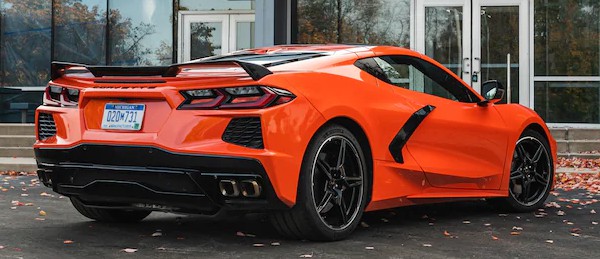 |
|
Which
parts look like a Corvette?
|
|
Surprisingly, what sits at the back of the cabin is still a push-rod
V8. In fact, it is the least changed element of the car. Dubbed LT2,
the latest version of GM small-block keeps the same bore center spacing
(which can be traced all the way back to 1955, incredibly), the same
bore and stroke dimensions hence the same capacity of 6162 c.c. Its
internals are much the same, too, as are the direct fuel injection,
variable valve timing on its sole camshaft, as well as the fuel-saving
cylinder deactivation system. It employs new stainless steel exhausts,
but the biggest change is the use of dry-sump lubrication, which allows
the engine to be mounted 25mm lower, improving center of gravity. The
V8 produces 495hp and 470 lbft of torque, an increase of 35hp and 5
lbft, respectively. The maximum torque now appears at 5150 rpm, 550 rpm
higher than before, although it doesn’t feel much different from 3000
rpm all the way to 6000 rpm. Peak horsepower arrives at 6450 rpm, 450
rpm up. Maximum rev is 6600 rpm, respectable for a push-rod V8.
A bigger departure from the old car is the transmission. Chevrolet
abandons conventional manual and automatic gearboxes and adopts a
brand-new 8-speed dual-clutch
transaxle from Tremec. It has an unusually short 1st gear ratio for
quicker
launch, so to produce headline-grabbing 0-60 time. In addition to a
launch control and GM’s multi-mode performance traction control
(as part of the track-oriented Z51
package), the C8 is claimed to be able to cut 0-60 in less than 3
seconds, a full second quicker than the old car! And, that is despite
the fact that it has gained 76kg of fat. A nicely equipped C8 with Z51
package and adaptive dampers tips the scale at 1643
kg, one of the heaviest in the mid-engined sports car field. A
Porsche 911 Carrera S is 115kg lighter.
 |
|
The
LT2 keeps the same bore center spacing as the first GM small block born
in 1955.
|
|
As before, the entire body shell is made of glass-fiber to keep
production cost down, while some inner panels are made of sheet molding
compounds. The chassis is still a backbone-type aluminum spaceframe
structure. The prominent backbone (transmission tunnel) is the main
load bearing. It comprises of 6 large pieces of high-pressure cast
aluminum parts. The rest include some rails, cross members and
subframes. Most of these aluminum parts are extrusions (40%) and
stamping (39%), others are casting (18%). They are put together by
laser welding, bonding, adhesives, flow-drilling screws and rivets. The
only non-aluminum structural
parts are 2 small steel struts, a magnesium instrument panel bracket, a
carbon-fiber rear bumper beam and a carbon-fiber
underbody panel. GM claims its torsional rigidity is up by 19 percent,
so the C8 can keep the Corvette's trademark Targa-roof arrangement,
whose roof panel can be detached and stored at the rear boot. A full
convertible is also available.
The suspension remains to be unequal-length double-wishbone all round,
but its
unique glass-fiber leaf springs have been replaced with conventional
steel coil
springs. Magnetorheological adaptive dampers remains an option under
the trading name Magnetic Ride Control. Another option allows the
front suspension to be lifted by 40mm to avoid the nose scratching
with pavement. Other handling aids include standard electronic LSD and
wide tires consisting of 245/45ZR19 and 305/30ZR20 Michelin Pilot Sport
ALS. The
aforementioned Z51 package will upgrade them to Michelin Pilot Sport
4S, in
addition to larger oil cooler, retuned suspension, revised axle ratio
and larger Brembo brakes. Meanwhile, a front lip spoiler and fixed rear
spoiler help to produce downforce of up to 180kg. Save the push-rod
motor, everything looks good enough to challenge Porsche.
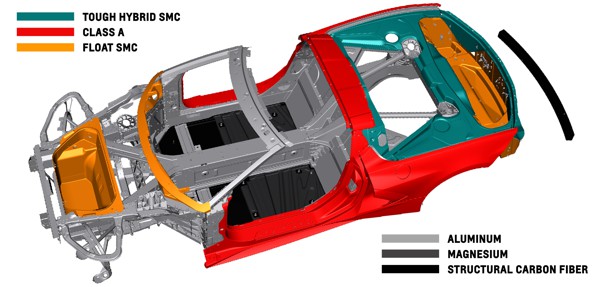
|
|
Despite
an aluminum spaceframe, the C8 is one of the largest and heaviest
mid-engined sports cars.
|
|
The C8 has grown in all dimensions bar height. At 4630mm long and
1934mm wide, it is 135mm longer and 57mm wider than the C7, also a lot
larger than a 911. Its 2722mm wheelbase is
very long even for a mid-engined sports car. It does look big, but more
problematic is a styling that places aggression above emotion. In my
eyes, this is the world’s ugliest mid-engined exotic since Noble M600. While you can forgive
the cottage industry for incompetent styling, no excuses can be said
for the superpower of GM design. Its exterior is said to be inspired by
stealth fighters F22 and F35, but I find it more like a mid-engined
Camaro. With too many angular styling elements and busy crease lines,
it does not possess the aesthetic of Italian exotics. It is even a
waste of the mid-engined proportion. A mid-engined exotic shall make
good use of its mechanical layout to enable a pointy nose and
wind-cheating shape. On this
car, the front bonnet is set so high that you might put an
engine underneath it. Its nose is so blocky that it doesn't seem to
slice through
the air easily. Since the waistline is set too high, the glasshouse
looks
small and the car feels heavy. The side engine intakes are arbitrarily
shaped, with no style to speak of, and their black linings look rough
and fragile. Turn to the back, all the squares and polygons highlight
the inelegant surface treatment and the low quality of glass fiber
panels. I remember TVR was good at using overlapping curvy surfaces to
hide the inconsistent panel gaps of glass-fiber. In contrast, the
designer of C8 uses thick edges to remind you that this car uses a
cheap glass-fiber body, not aluminum or carbon-fiber. Modern sports car
designs cannot be much worse than this one.
Yes, this is really disappointing. For decades, countless of designers
and car lovers dreamed of how a mid-engined Corvette would look like.
Unexpectedly, GM's designers have screwed up a golden opportunity. They
just built a mid-engined muscle car.
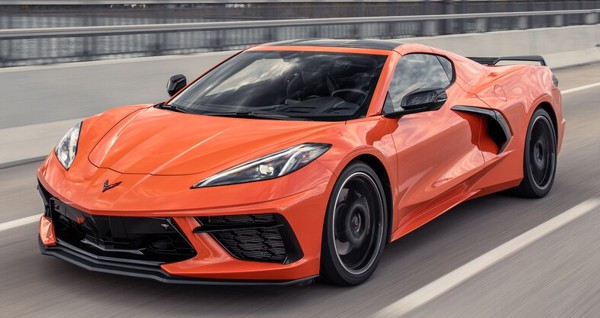 |
|
GM's
designers have screwed up a golden opportunity. They just built a
mid-engined muscle car.
|
|
Don’t get me wrong, I have been an admirer of
Corvette since the days of C4. Corvettes from C4 to C7 might not be the best
to drive, but they all looked fantastic –
fast, pure and tasteful. Whenever we mention “American
sports car”, the first to come in mind is their iconic shapes. Sure, to
modernize an icon is never easy, but it is not impossible. Porsche
succeeded in evolving the classic 911 to 993, then 996, 991 and today’s
992 without losing its genes. If you talk about a big change of
mechanical layout, Fiat 500 and
Volkswagen New Beetle prove that it is possible to transform
rear-engined classics into front-engined moderns yet keep them
recognizable. Ditto the rear-engined-turned-mid-engined Alpine A110.
Good designers shall be able to capture the spirit of the icons and
find ways to interpret that in modern mechanicals. If I pen this car, I
might give it softer lines, more curves, a faster angle nose, a lower
and more flowing waist line, wrap around rear screen and quad-circular
tallights. Yes, just like a mid-engined C5 ! Make it pure and simple,
and you will have something to give Ferrari a lesson.
At times, the C8 gives me an impression that it is not a true Corvette.
Just because some GM engineers have the ambition to build a poor man’s
Ferrari, they make use of the C8 budget to realize their dreams. It has
a very different personality from any Corvettes we know.

|
|
The
interior is a huge step forward in style and quality perception.
|
|
Not all changes are as poorly executed as the exterior. The interior of
C8 is a really a huge step forward in style and quality perception. Its
jet-fighter cockpit design is even more spectacular than that of the
C7. Materials feels expensive if you take the 3LT premium package, with
almost every surface trimmed with leather, Alcantara or carbon-fiber.
The smell of resin and plastic is gone. The driver-oriented touchscreen
and reconfigurable instrument display look sophisticated and work well.
Ditto the square steering wheel which gives you a better view to the
instrument display. Although fit and finish or the tactility of
controls still fail to match Porsche, this place feels expensive for
the first time in the 67 years history of Corvette!
On the downside, ergonomics is still somewhat flawed. You certainly sit
farther forward than the case of any front-engined Corvettes, but
forward visibility is no better, because the windscreen is not wrap
around like Lotus or McLaren, and the bonnet is set high, blocking part
of the view ahead. Car & Driver did a measurement and found it
actually see 3 feet less of the road ahead compared with the C7, which
is ridiculous. The long dashboard also reflects on the windscreen under
sunlight. The slim row of gloss buttons on the sloping transmission
tunnel might look a statement of style, but under light reflection they
are rendered unusable.
Space is also a problem, unexpectedly. Despite the increase of exterior
dimensions and weight, the C8’s cockpit offers a bit less legroom,
shoulder room as well as hip room than the C7. Its driver seat is
mounted unusually high, presumably to lessen the visibility problem.
Even when set to the lowest position it feels too high for a sports
car. It also robs the driver headroom, making the C8 unsuitable for
taller drivers. The passenger is no much better. Although the seat is
mounted lower than the driver’s, the prominent transmission tunnel
leaves the passenger no space to put his left arm.
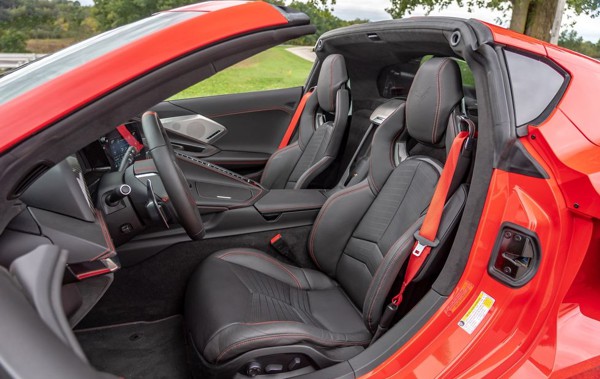 |
|
High-mounted
driver seat leaves little headroom.
|
|
Luggage space also suffers from the switch to mid-engine. While the C7
has a 424-liter boot, the C8 can swallow only 357 liters, and it is
split between a very small front boot and a still quite small rear
boot.
On the Road
Well, a mid-engined exotic is not supposed to be as practical as a
performance saloon. What matters is how good it drives. Surprisingly,
the C8 thinks itself as a performance saloon when you call for
excitement.
Is it quick? No doubt, the figures don’t lie. Both Car & Driver and
Motor Trend timed a C8 with Z51 package’s shorter gearing to sprint
from 0-60 in 2.8 seconds, a shocking figure for a car so affordable.
The mid-engined machine’s 61-percent rearward weight bias plays a key
row here, as do the 305-section Michelin PS 4S rubbers and the very
effective launch control. Up to 100 mph, the C8 can still go head to
head with a 911 GT3, a Honda NSX or a Nismo GT-R. Thereafter, it slips
back a little, but still it is faster than it has any rights to be.
The problem lies in not the objective measurement but how you feel
sitting inside the car. The C8 never feels half as quick as it goes.
Power delivery of the push-rod V8 feels flat, with no particular surge
or change of tone when you wind it up. 6000 rpm doesn't feel much
different from 4000 rpm, except that the scenery outside moves faster,
so why bother to push it? The exhaust note of the V8 is subdued,
lacking the scream and roars you would expect for a high-performance
sports car. At low speed and on cruising, it is even as whisper-quiet
as a luxury car. Ferrari and Porsche just won’t tune their engines like
that. Not the C7, too. A sports car has to feel special all the time.
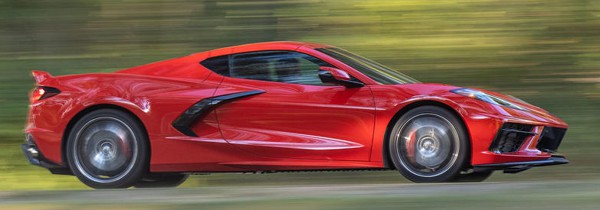
|
|
The
C8 never feels half as quick as it goes, and it steers like a
front-wheel-drive car...
|
|
Well, it wouldn’t matter if it cornered like a Porsche or Lotus.
Unfortunately, it is not. Far from that actually. The C8 offers
tremendous grip and stability undoubtedly, but it feels bigger, heavier
and more inert in its response than a mid-engined sports car supposed
to be. Road tests confirmed that it produces lower cornering g-force
than the C7 and longer braking distance as well. Its lap time is no
match for a 911 Carrera S with lower power-to-weight ratio. The car’s
excessive weight is to blame, but equally responsible is the tuning
strategy: GM built too much understeer into its chassis. Whether it is
deliberate or not I don’t care, but the fact is this car understeers a
lot mid-corner. If you think more throttle would balance the understeer
and turn it into oversteer, wrong! It will understeer even more, just
like a front-wheel-drive car (and a poorly tuned one!). The only way to
get
rid of understeer is to back off immediately, then the nose will tuck
in a little, returning to neutral. Yes, just like a hot hatch. However,
with so much grip on offer, such lift-off balance is not as easy to
access as a hot hatch. Surely not on a narrow mountain road. The
Corvette rests on a much higher performance level, so you need a track
and load it very hard to get into its sweet spot, even though that
sweet spot is not that sweet.
There is some talk about different camber settings. When set according
to the factory’s guidance for track use, the understeer can be
significantly reduced. However, the Vette is a road car. Isn’t it shall
be tested with the factory road setting?
The problems don’t lie on the balance alone, but the controls are also
flawed. The steering is light and accurate but lacks feedback at road
speeds, certainly not what you would expect from a manufacturer giving
us the feelsome racks of Camaro, CTS and ATS. The drive-by-wire brake
pedal is bit non-linear, and it is easy to trigger ABS. The Tremec
twin-clutch gearbox is smooth and consistent, but don’t expect the
lightning shift time of Porsche or Ferrari.
Ridiculously, the C8 excels when it is driven leisurely. In Touring
mode, its ride is more comfortable than Porsche. Its engine is quieter.
Sound insulation is better than most sports cars. Its steering is
lighter than a family car’s. I am puzzled. What kind of buyers does it
target at? What does it want to achieve with this revolutionary
makeover?
To be the world’s most comfortable sports car? The world's first
mid-engined grand tourer?
To be fair, the C8 is not supposed to rival a 911 or even a Ferrari. A
well-equipped C8 with all the essential performance and interior
enhancements can be bought with less than $90,000. It is about the same
as a Porsche 718 GTS. The Vette is much faster in a straight line, and
probably on a track as well (you will need at least a GT4 to rival it).
Still, driving thrills are not the function of speed. The Porsche is
definitely more fun to drive and more satisfying to own, especially now
it comes with 6-cylinder power again. Meanwhile, an A110 is also a much
sweeter driver's car, although it comes with only a 4-cylinder engine
and it is not sold in America. The C8 is not only not much fun to
drive, but not much fun to look and to listen. It is therefore a big
disappointment. Let's hope the go-faster versions will adopt a
different strategy.
|
Verdict:    |
Published
on 30
Oct 2022
|
All rights reserved.
|
|
Corvette Z06
|
|
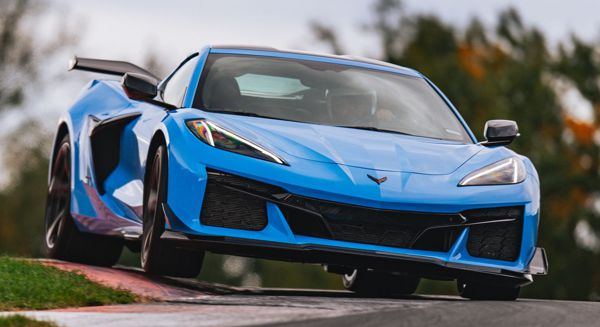
|
|
With
a world-class engine, the go-faster Corvette is finally a world-class
sports car.
|
|
When the new Corvette was
transformed into mid-engined a couple of years ago, it was already
referred to “the American Ferrari”. However, what kept it from really
catching Ferrari on performance terms is its old-school pushrod "small
block" V8,
which produces just under 500 hp and revs to no more than 6600 rpm.
That was the last tie to all the old Corvettes and a key factor to its
affordable price. Logically, the go-faster version, Z06, should have
used a supercharged small-block V8 like its predecessor. That would be
cost effective yet produces plenty of power and torque (650 hp and lbft
last time) to challenge Ferrari. Somehow, the Corvette team thought it
is not exotic enough, so they buy a Ferrari 458 Italia, disassembled
its 32-valves flat-plane crank V8, copied every novel feature from it
and benchmarked the new Z06 against it. The result is nothing short of
amazing.
Codenamed LT6, it is the first ever DOHC 32-valve V8 developed by the
Corvette team – the ZR-1
running from 1990-95 had a 5.7-liter 32-valver developed by Lotus. It
keeps the same 112 mm bore spacing of the existing small-block V8 for
ease of installation, but it is an all-new design. The Ferrari-style
flat-plane crankshaft skips counterweights of traditional V8s for
reduced inertia, allowing the LT6 to rev to 8600 rpm. Displacement
drops from 6.2 to 5.5 liters in the process of chasing rev, as bore is
enlarged to 104.25 mm while stroke is shortened massively to 80.0 mm.
The shorter stroke, in combination with using forged titanium
connecting rods (another Ferrari trick), help reducing the second-order
vibration known to flat-crank V8s. Vibration damper, stiffer engine
mounts and a stronger transmission casing take care of the remaining
vibration.
The dry-sump lubrication also copied Ferrari’s idea. The crankcase is
sealed in 4 separate chambers, one for each pair of cylinders, and each
chamber has its own scavenge pump. This prevents air goes repeatedly
from one crank throw to another crank throw, reducing windage or
pumping loss within the crankcase.

|
|
A
lot of novel features are copied from Ferrari 458 Italia, the car its
development team bought and studied.
|
|
The combustion chambers run at 12.5:1 compression ratio. The
CNC-machined cylinder heads house carbon-coated finger followers,
titanium intake valves and sodium-filled stainless steel exhaust
valves. Like the Ferrari engine again, the LT6 employs 2 intake plenums
(though made of thermoplastic here) which are interconnected through 3
valves to form a resonance-type variable intake system. This improves
torque delivery across the entire rev range, something very important
because the short-stroke engine doesn't produce as much torque as the
regular small-block. The 4-2-1 stainless steel exhausts connect to a
quad-tailpipe, which has been relocated from the sides to the center of
the tail. Overall, the LT6 is only 14 kg lighter than the supercharged
6.2-liter LT4 unit of its predecessor, as the DOHC architecture partly
offsets the loss of supercharger and displacement.
The 5.5-liter engine produces 670 horsepower at 8400 rpm, 175 ponies
more than the standard Corvette. Its specific output of 124 hp per
liter is among the highest in the normally aspirated world, with just a
few examples could better it, e.g. Ferrari 812 Competizione (128 hp/l),
Porsche 918 Spyder (132 hp/l), Ferrari 458 Speciale (135 hp/l), Aston
Martin Valkyrie (154 hp/l) and Gordon Murray T.50 (166 hp/l). It also
beats the 631 hp Mercedes-AMG
SLS Black series to be the world’s most
powerful atmospheric V8. Admittedly, aside from Detroit car makers, no
one builds NA V8s anymore.
On the downside, its maximum torque drops from the standard car's 470
lbft to 460 lbft, and this is not available until hitting 6300 rpm. As
a compensation, the Z06 employs a shorter final drive ratio. The Tremec
8-speed dual-clutch gearbox has strengthened clutch pack and stronger
casing. An active differerential is standard, working with GM's
Performance Traction Management system.
The regular C8 is already a big car, but the Z06 is bigger still – 88
mm longer and 90 mm wider. That extra width is needed to accommodate
its astonishingly large Michelin Pilot Sport 4S tires: 275/30ZR20 up
front and 345/25ZR21 rear. For comparison, a Ferrari F8 Tributo – an
even more powerful car – uses 245 front tires and 305 rear tires. The
Z06 is 111 mm longer, 45 mm wider and 29 mm taller than the Ferrari,
accompanied with 72 mm longer wheelbase. As the body shell is still
made of fiberglass like the standard Corvette, unsurprisingly, it
stands at the heavy side of its segment, weighing 1663 kg according to
the scale of Car and Driver. That’s about 200 kg more than the latest
Porsche 992 GT3 RS and about the same heftier than the Ferrari.

|
|
Z07
pack lifts the Z06 to one fo the fastest cars on track.
|
|
You can make the car a bit lighter by opting for the very expensive
carbon-fiber wheels. It will set you back at $10,000 but saves 18.5 kg
of unsprung mass. The latter could be valuable, because the Z06’s
suspension is 35 percent stiffer than the Stingray fitted with Z51
handling package. Its magnetic dampers are also set stiffer, while
helper springs are employed for improved body control. The Brembo
brakes get larger – 370 mm discs and 6-piston calipers up front, 380 mm
and 4-pot calipers at the back.
And then there is a $9000 performance package confusingly named Z07. It
stiffens the suspension by a further 8 percent, turns to Michelin Cup 2
R semi-slick rubbers and Brembo CCM ceramic brakes. To equip this pack,
you need to also tick the $8500 carbon-fiber aero kits which includes a
large rear wing, larger front splitter, front dive planes and underbody
strakes. Chevy said it produces 333 kg of downforce at 186 mph. Not in
the league of 911 GT3 RS, of course, but still pretty good.
The bad news is ballooned price. Fast Corvettes used to be performance
bargain. Although the new car is still relatively cheap compared with
European marques, it is no longer as bargain as before. A lean Z06
starts at $110,000 including gas guzzler tax (yes, it is thirsty),
breaking into 6-figures price for the first time. Upgrade to 3LZ trim
(which gets niceties like premium Hi-Fi, leather upholstery, better
infotainment system and seats), add the aero package and Z07
performance pack and it will end up at $141,000. And that’s before
considering carbon-fiber wheels, roof and a few carbon-finish options.
The car tested by Car and Driver has a very European-like price tag of
$166,000. That’s also the base price of 911 GT3. If the American car is
imported to Europe, I am sure the price gap will be even narrower.
On the Road
Few cars could rival the Z06 for 0-60 sprint. While it is not the most
powerful, it has a fast-shifting DCT, a good launch control, plenty of
traction thanks to the mid-engined layout and, most important, a set of
super wide and sticky tires, especially the Michelin Cup 2 R that comes
with Z07 package. A 0-60 time of 2.6 seconds is outstanding, barely
slower than 911 Turbo and Turbo S, which are rear-engined cars with
4WD. Unsurprisingly, it is faster than the old Ferrari 458 that it
benchmarked, not just for 0-60 mph but all indicators up to 140 mph.
The newer turbocharged 488 and F8 are faster, of course, let alone the
latest 296
GTB with hybrid power, or just about any McLaren sports series.
However, those are lightweight supercars and should not be compared
with the relatively affordable Z06.

|
|
Interior
looks expensive, but the Z06 also gets very expensive.
|
|
The LT6 feels very different from traditional small-block, with an
eagerness to rev and sharp throttle response never seen before. It
sounds very different, too, replacing traditional burble with a
high-pitch noise. There is plenty of torque low down, but the true
excitement starts from 4000 rpm, then hardens again at 6000 rpm and
pushes all the way to
8600 rpm redline with a relentless manner, while the exhaust gets
exponentially insane, screaming like a racing motor. Unsurprisingly, it
sounds a bit like Ferrari V8s, rawer and angrier than the flat-crank V8
of Ford Mustang GT350.
The driving experience is a bit compromised by the ergonomics though.
As in the standard car, you sit a little too high and visibility is not
great. The long dashboard cause reflection under sunlight, as are the
buttons on transmission tunnel. The square steering wheel is barely
more useful than the yoke of Tesla.
The ride is quite stiff on less than smooth roads, and those beefy
tires generate so much noise that cruising refinement is seriously
compromised. On a mountain road, its massive width is certainly
something
you should watch carefully, preventing you to drive as hard as any 911s
or even Ferrari. No, the Z06 is designed for a country with wide empty
roads, or better still, big race tracks.
On track, the Z06 with Z07 pack drives like a dream. You get massive –
I mean massive – grip and traction to rely on. Tight body control,
responsive turn-in, accurate steering, mighty ceramic brakes, all
qualities are up to the highest level. Not even mid-corner bumps could
shake its stability. Undoubtedly, it will be extremely quick on track.
However, its biggest weakness is exactly its biggest strength: grip.
Even on standard Pilot Sport 4S tires, the Z06 is so grippy that hard
to get it spin. If you turn off traction control, you can ultimately
push it to oversteer, but it lacks the delicate balance of the very
best sports cars, so holding its slide will be difficult, let alone
controlling the slide angle at your will as in a mid-engined Ferrari
with Side Slip Control. And that’s on a wide race track. Don’t forget
Ferrari is capable to slide corner after corner in the Swiss Pass. On
Cup 2 R rubbers, the Corvette’s roadholding limit is even higher, thus
you need to push even harder to break its traction. Again, it does not
encourage sideway driving. More like the C8.R race car, it prefers to
corner accurately, losing no time in slide. That robs it the
opportunity
to engage its driver with highest satisfaction.
Concerning styling, the Z06 might be better looking than the standard
car, thanks to wider fenders and larger wheels that make it look
like lower and lighter, but the design is still too edgy and busy for
my taste. Apart from engine, perhaps it should learn the
great styling of Ferrari 458 as well.
|
Verdict:     |
Published
on 2
Dec 2023
|
All rights reserved.
|
|
Corvette E-Ray
|
|

|
|
The
first hybrid as well as AWD Corvette.
|
|
The C8 sets many firsts for
Corvette: the first mid-engined Vette, the first to employ flat-plane
crankshaft V8 (that’s for Z06), and now the first hybrid-powered as
well as 4-wheel-drive Vette. Hard to imagine these just a few years
back!
The E-Ray Corvette keeps using the LT2 push-rod V8 from the standard
Stingray. Its output remains unchanged at 495 hp and 470 lbft, and it
keeps driving the rear axle through a Tremec twin-clutch gearbox. What
the E-Ray adds is a small electric motor at the front axle, which
provides another 160 hp and 125 lbft. As it works through an open
differential, wheelspin and under/over-steer are taken care by
brake-based torque vectoring strategy.
With a combined output of 655 hp and 595 lbft, in addition to 4-wheel
traction, the E-Ray is capable to storm from rest to 60 mph in 2.5
seconds, a tenth quicker than the mighty Z06, even though it carries
300 pounds more. For sure the E-Ray’s superior torque (especially at
lower revs) and extra traction are the main reasons. Once the Z06
overcomes wheelspin, it will claw back the lost ground. At 150 mph, the
E-Ray is not only a full second adrift of Z06, but its electric motor
will be disengaged from the driveline to avoid damage, then it will
climb slowly to its 183 mph top speed using its pushrod engine alone.
If you think the E-Ray must be more frugal to run than other Vettes,
you will be disappointed to find out its fuel economy the same as the
Stingray. That is because it uses a smallish lithium-ion battery with
merely 1.9 kWh (gross) capacity. (For reference, both Ferrari 296 and
McLaren Artura employ a 7.4 kWh battery.) As a result, its
zero-emission range is barely 3-4 miles, and the V8 will fire up once
above 45 mph. Make no mistake, this is not a green car, but a
performance-oriented hybrid. It cannot be plugged in to recharge, as
the battery is charged through either harvesting excess energy from
engine or regenerative braking.
On the plus side, the smallish battery is both cheaper and easier to
package. Chevy is able to put it in the space within the transmission
tunnel without any structural modifications. The E-Ray is no
lightweight at 1800 kg, but compared with the 1643 kg Stingray or 1663
kg Z06, its weight penalty is rather modest.
The rest of the car is largely based on the Z06, sharing the latter's
wider body to accommodate the same oversized tires - Michelin Pilot
Sport 4S, 275/30ZR20 front and 345/25ZR21 rear, although they are
all-season instead of summer rubbers by default. Magnetic Ride Control
dampers is standard, ditto carbon-ceramic brakes and a lithium-ion 12V
battery. All these make its $104,000 starting price looks a relative
bargain beside the $111,000 Z06.
However, the E-Ray has a different personality. If Z06 is Corvette’s
equivalent of 911 GT3, then the E-Ray is a 911 Turbo. With endless
torque on offer at any revs, you don’t need to wind up its engine to
get the best out of it. Supercar performance cannot be obtained any
easier.
Moreover, it is easier to drive to the limits. Breakaway in fast
corner is more progressive, and the front wheels will stabilize the car
when the rear gives up.
Using purely as a road car, the E-Ray is easily livable. It can start
and leave your garage silently in early morning. The magnetic dampers
provide comfortable ride. All the comfort and practical design features
of the standard Corvette remain. The only complaints are excessive tire
roar (think of 345mm rubbers) and the 2-meter-plus width that makes it
hard to exploit on narrower roads.
|
Verdict:     |
|